The Rise of Dark Bathroom Faucets: A Trend Analysis
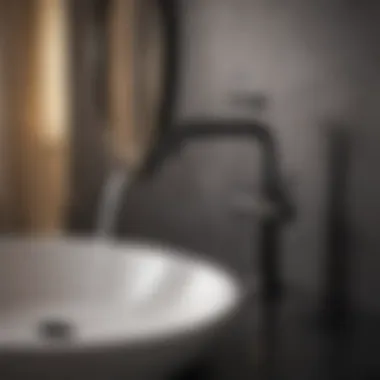
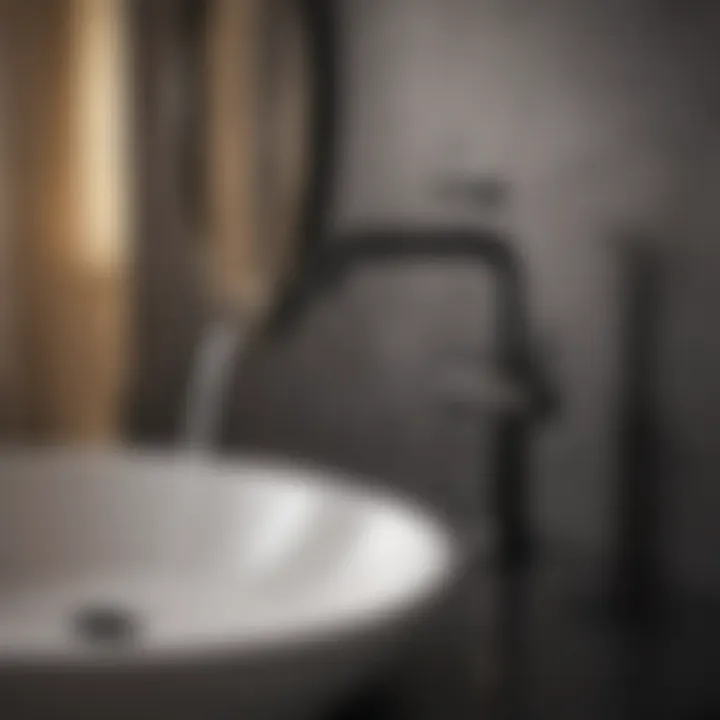
Intro
The emergence of dark bathroom faucets is reshaping home design trends. Homeowners and designers alike are recognizing the unique elegance that these fixtures bring to the space. The aesthetic is undeniably appealing, offering a sophisticated contrast to traditional lighter finishes. This change marks a notable shift in bathroom décor, pushing beyond conventional notions of color and style. Embracing darker tones can dramatically alter the ambiance of a bathroom, making it more inviting and contemporary.
Choosing dark faucets encompasses various dimensions, from materials and finishes to integration within existing designs. As homeowners begin to explore this trend, understanding the intricacies involved can greatly enhance the final results. In this article, we will examine essential considerations for incorporating dark faucets and provide insightful guidelines for a seamless transformation.
Materials:
To embark on successfully installing dark bathroom faucets, it’s vital to gather the proper materials. Below is the itemized list necessary for this endeavor:
- Dark Bathroom Faucet: Standard size, 8-inch widespread installation preferred
- Faucet Supply Lines: **3/8 inch x 20 inch rubber-lined stainless steel supplies
- Plumber's Putty: 1 small container
- Teflon Tape: 1 roll, for ensuring no leaks at connections
- Adjustable Wrench: 1 (10-inch or larger recommended)
- Screwdriver Set: Flathead and Phillips included
- Basin Wrench: 1, for tight spaces under the sink
- Tape Measure: At least 25-inch, to measure spaces accurately
- Safety Goggles: 1 pair, to protect eyes
- Gloves: 1 pair, reusable or disposable gets a grip while working
DIY Steps:
Detailed Instructions:
- Shut Off Water Supply: Start by turning off the water valves under the sink. Turn off both hot and cold supplies.
- Clear Sink Area: Remove any objects around the sink area, ensuring clear space for installation.
- Remove Old Faucet: Using a screwdriver and basin wrench, take out the old faucet. Loosen the nuts beneath the sink.
- Apply Plumber’s Putty: Take the plumber's putty and create a ring for the base of your new dark faucet to installed correctly.
- Install New Faucet: Position the new faucet in place, pushing it firmly into the putty ring. Secure beneath with then nuts.
- Connect Supply Lines: Follow this with attaching the supply lines to the respective water inlet. -Use Teflon Tape: Apply tape to further prevent leaking.
- Turn On Water Valve: Gradually turn back on the water supply to check for leaks and ensure correct installation posture.
- Test for Leaks: Run the faucet and watch for water escaping from under the sink.
Technical Aspects:
These steps often require expertise, so an understanding of tools and timing is essential. Here is essential tool information and insights to propel your installation:
- Tools Needed:
- Timing Specifics:
- Critical Techniques:
- Adjustable Wrench or Basin Wrench will save time with tricky twists.
- Screwdrivers, both flathead and Phillips.
- Expect around 1-2 hours for the entire process.
- Executing measurements accurately for fitment proves vital while ensuring no overlap with sink elements.
DIY Project Process:
Sequential Steps:
Sticking to methodical installation points maintains life cycle longevity of the faucet.
- Clear the area thoroughly.
- Adopt a relaxed pace and regularly evaluate your progress.
- When re-connecting, ensure alignment perfects fitting.
- Keep all tools comfortably accessing without moving to and away to inconvenience.
Troubleshooting Tips:
If complications arise, consider these practical solutions:
- If leak occurs: Disconnect supply lines, inspect fittings, and reapply Teflon tape.
- Struggling to fit into position: Relocate and gently hand-tighten until barely locking.
To ensure project success, establish planned phases and never compromise safety.
This thorough installation process enables a remarkable transformation. Enjoy the cohesion of dark faucets in your bathroom to elicit the new obscure elegance.
Prologue to Dark Bathroom Faucets
The rise of dark bathroom faucets marks a significant trend in modern interior design. Homeowners increasingly seek stylish and functional fixtures to elevate their spaces, particularly in bathrooms, which often serve as a personal sanctuary. Dark faucets serve not only an emphatic functional role but also an aesthetic one, adding depth and drama to an otherwise serene environment. Marketing these features both appeals to changing taste and pushes innovation in design.
Defining the Trend
The trend towards dark bathroom faucets encompasses a variety of finishes, including matte black and oil-rubbed bronze. These choices present an elegant contrast to lighter bathroom themes, which were predominant in earlier design approaches. Dark faucets are linked to modernity and sophistication. Their growing popularity stems from a societal shift that embraces bolder interiors, moving away from traditional and sometimes dull options.
Key Aspects of the Trend:
- Modern aesthetic appeal
- Versatile design compatibility
- Reflects contemporary values in home decor
Historical Context of Bathroom Fixtures
To fully appreciate the rise of dark bathroom faucets, it’s essential to examine the history of bathroom fixtures. In the early 20th century, bathroom design primarily focused on sanitary elements with light, shiny metals. Chrome and polished nickel were commonplace, ensuring surfaces were cleaned and remained gleaming. Gray and beige hues were preferded; however, as design trends evolved throughout the decades, alternative colors and materials began to emerge. The 21st century witnessed an acknowledgement of individuality in homes and a tension with uniformity.
In recent years, darker finishes have become favorable, appearing as a responsive design choice against overly bright rooms. This divergence from tradition signifies a profound change in how indoor spaces associate with personal expression. Dark faucets symbolize not just taste, but a broader understanding of style in homes going beyond simply 'neat and tidy.' Homeowners now demand fixtures that complement sophisticated colors and contribute to a unified aesthetic.
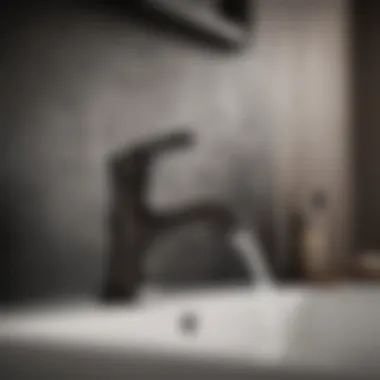
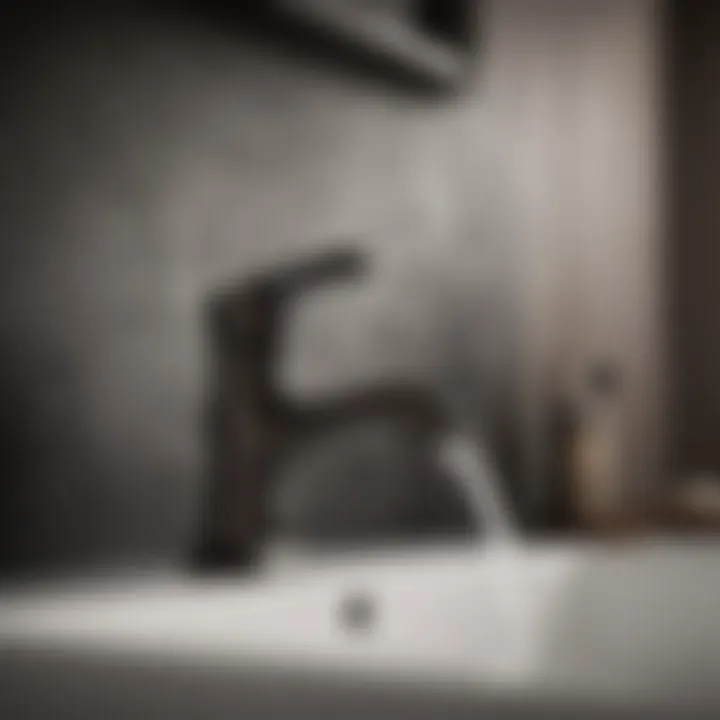
The shift towards darker materials represents a liberating change rooted in decades of evolving styles. Recognizing and understanding these historical contexts helps to explain the newfound desire for meanigful and rich options in interiors.
Aesthetic Appeal of Dark Faucets
The aesthetic appeal of dark faucets is a crucial facet of modern bathroom design. This trend resonates deeply with homeowners aiming to create sophisticated environments. Dark faucets serve as both functional and decorative accents that can complement or contrast the overall theme of a bathroom.
Visual Impact in Modern Interiors
In contemporary settings, dark faucets make a significant visual statement. Their bold, sleek appearance can enhance the overall decor. Typically finished in colors like matte black or oil-rubbed bronze, these faucets radiate elegance.
Dark faucets draw the eye, acting as focal points. When juxtaposed with lighter colors or textures, they stand out more prominently, providing a striking contrast. While light and airy designs remain popular, darker finishes can add depth and dimension.
Homeowners should consider the enabling of a visual narrative when choosing fixtures. For instance, a dark faucet on a white or light wood countertop elevates the sophistication of the ensemble. The minimalist approach, paired with striking features such as a dark faucet, draws attention while maintaining a clean look.
"Dark faucets not only enhance the luxury aesthetic, They are versatile in addition to presenting a inherent simplicity."
Contrasting Elements and Color Schemes
The interplay of dark faucets with other opposing colors introduces unique possibilities for design schemes. Combining them with bright elements creates a dynamic environment where differing shades play against each other. For instance, pairing dark faucets with earthy colored tiles brings vibrance to natural textures without overwhelming.
Here are different color schemes to consider:
- Monochromatic: Using shades of gray with dark faucets offers an understated elegant look.
- Complementary: A mix of dark finishes with soft whites or pastels can soften overall aesthetics while maintaining sophistication.
- Accent: Place dark faucets in connection with bold colors, such as deep greens, providing dramatic contrasts that capture attention.
Determine how much contrast you desire, and align it with the overall sensibility you wish to achieve. The appropriate balance can define a room's character. Ultimately, selecting a dark faucet goes beyond mere utility; it’s a design choice that transforms spaces, making them alluring yet functional.
Material Choices for Dark Faucets
Choosing the right material for dark bathroom faucets is crucial, as it not only influences the appearance but also affects durability and functionality. Understanding material options helps homeowners make informed decisions. Different finishes have unique properties that play a substantial role in their popularity. They impact not only the aesthetic but also the maintenance, compatibility, and overall experience in using dark faucets in bathrooms.
Finishes Available
Matte Black
Matte Black has surged in popularity due its sleek and modern finish. One key characteristic of Matte Black is its non-reflective surface, which can be appealing in a minimalistic design. This finish complements a wide variety of bathroom themes effectively. Despite its elegance, Matte Black can show water spots and fingerprints more than other finishes. This necessitates wiping down the faucet regularly to maintain its attractive appearance. It is a beneficial choice for homeowners seeking a sophisticated, yet understated look. The elegance of Matte Black flows nicely with contemporary and industrial decor.
Brushed Nickel
Brushed Nickel is another popular option favored for its durability. A key characteristic of this finish is its resistance to corrosion and tarnish. This characteristic means it maintains its appearance for a long time and is less prone to wear. Brushes in this finish also provide a unique texture for grip. Due to its neutral tone, Brushed Nickel can combine well with various color schemes without clashing. However, it can sometimes appear muted in rooms that use brighter themes. This makes at least some planning necessary to ensure this finish complements the entire environment. Brushed Nickel reinforces a timeless aesthetic without being overly stringent on the style.
Oil-Rubbed Bronze
Oil-Rubbed Bronze is appreciated for its rich texture and dark, aged appeal. Its key characteristic is an antiqued look that perfectly meshes with traditional or rustic design preferences. It brings with it a sense of warmth and unique identity, which resonates well in vintage-styled or classic setups. A benefit of using Oil-Rubbed Bronze is the aura of elegance it conveys, enhancing the overall atmosphere of any bathroom. Yet, it's crucial to recognized that Oil-Rubbed Bronze can be susceptible to wear if not properly cared for. Regular maintenance helps preserving its refined charm while oxidative properties that generate patina will change the finish over time, making every piece uniquely embedded with its history.
Durability and Longevity
Investing in faucets with superior material choices means considering their durability and longevity. Homeowners will discover that higher-quality materials withstand daily use more effectively. Each finish discussed earlier highlights how specific materials directly correlate to their lifespans. Regular checks can ultimately help homeowners extend the functionality. Taking time to select a robust faucet material can lead a long-term satisfaction worth the budget. Effective utilization of these finishes can lead to maximizing investment and minimizing future engagements with fluctuating replacements.
Installation Considerations
When introducing dark bathroom faucets into your home, installation considerations become one of the fundamental aspects that determine the overall success of this design choice. Proper installation not only ensures functionality but also preserves the aesthetic appeal of these fixtures. Many homeowners overlook these elements, focusing predominantly on style rather than how well the faucets will work with their existing infrastructure.
Professional Installation vs.
DIY
Choosing between professional installation and a do-it-yourself approach is an important consideration. Hiring professionals may require a higher initial investment, but their expertise can avoid common pitfalls and elaborate on best practices that an average homeowner might miss. They can handle the technical aspects such as plumbing adjustments or compatibility checks, which is intricate if your plumbing system has unique requirements.
On the other hand, the DIY method is less costly and offers flexibility. Many individuals find satisfaction in personally enhancing their homes. However, this route demands a precise understanding of plumbing systems, tools, and safety standards. If deciding on a DIY approach, ktaking time to research detailed tutorials and procedures from credible resources, such as Wikipedia and Britannica, can be invaluable.
Pros and Cons of Each Approach
- Professional Installation
- DIY Approach
- Expertise Speeds Up Process
- Reduces Installation Errors
- Often Comes with Guarantees
- Cost-Efficient
- Allows for Greater Personalization
- Control Over Scheduling
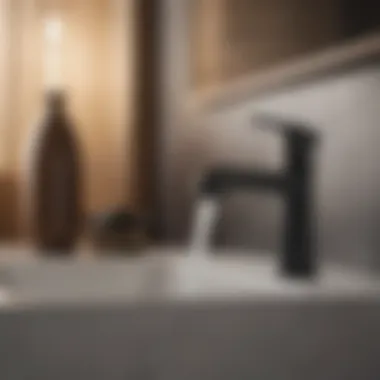
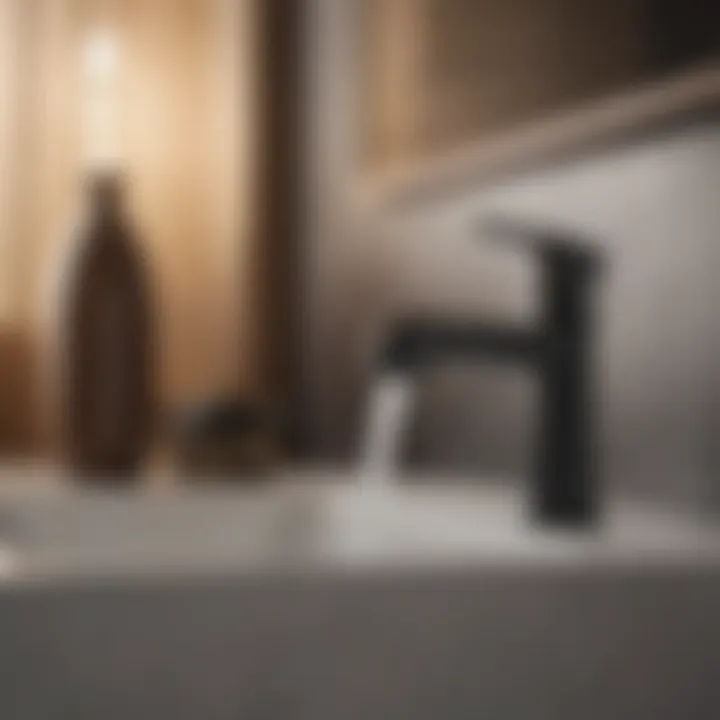
Ultimately, the decision depends on both your budget and comfort level with hands-on installation tasks.
Compatibility with Existing Plumbing
Assessing compatibility with your existing plumbing is crucial for a seamless installation of dark bathroom faucets. Before choosing your faucets, consider the current setup, including water pressure and pipeline materials. Proper sizing and connection types are fundamental; a mismatch can lead to leaks or insufficient water flow.
Dark faucets often fit a variety of configurations, yet it's indispensable to double-check these specifications against your current plumbing. Materials such as copper, PVC, or PEX have different coupling needs. Reviewing manual guidelines from your faucet manufacturers and consulting with professionals is advisable. This vigilance transforms anxiety into empowerment when adopting this stylish trend.
Remember: Proper compatibility and adequate installation can save you from costly repairs down the line and enhance the overall enjoyment of your new dark faucets.
Psychological Effects of Color in Bathrooms
The significance of color in bathrooms, especially darker hues, cannot be underestimated. Various studies indicate that color affects mood profoundly. By examining the psychological effects of color, one can classify darkness as both a visual aesthetic and a feeling contributor. Dark fixtures, such as faucets, create environments that offer unique emotional experiences.
The Role of Darkness in Design
Utilizing darker colors in bathroom design results in deeper visual impacts. These shades can evoke a sense of refinement and sophistication when compared to traditional lighter colors. Dark colors often create defined spaces by providing shelter to the eye, thus emphasizing other elements in the design. This impact holds true for dark bathroom faucets, which can serve as a stylish focal point amidst lighter surroundings.
Furthermore, designing with dark colors helps establish a more intimate and cozy atmosphere, an important aspect for private spaces like bathrooms. This depth enhances specific features, especially lighting fixtures and wall decor, allowing for contrast. Fixtures are not merely utilitarian; in a context of sophisticated design, they become integral aspects expressing personal styles.
Creating a Soothing Environment
Establishing a calming bathroom environment is essential for overall well-being. Dark faucets play a notable role here. These fixtures create a contrasting ambiance with lighter tones of tiles and walls, coupling functionality with aesthetic balance. By integrating dark elements, homeowners can control visual time-outs, grounding the characteristic hustle of daily routines.
Some key considerations include:
- Thinking about lighting: Specific placements enhance or nullify darker shades.
- Selecting complements carefully: Dark faucets harmonize with individual tastes, combining with vivid colors and styles from the home.
- Reflecting personal preferences: Everyone has different reactions to color; what may seem calming to one individual could be overstimulating to another.
Color sets the tone for that environment—dark and rich tones can frame a serene bathing experience when thoughtfully integrated to enhance light sources.
Utilizing dark bathroom faucets allows homeowners to craft a lifestyle that welcomes peace and serenity, vital for morning routines or unwinding times.
Maintenance and Care for Dark Faucets
Maintaining dark bathroom faucets is crucial for ensuring they retain their aesthetic appeal and functionality over time. This emphasizes the importance of committing to regular upkeep. Dark finishes can enhance the overall design of a bathroom. However, they can also show wear or stains more easily than lighter finishes. Clear maintenance strategies can prolong their life and keep them looking their best.
Regular Cleaning Routines
Establishing consistent cleaning routines is essential. Different materials require varying cleaning methods to avoid damaging the finish. Dark faucets can gather soap scum, water spots, and other residues, becoming unsightly if neglected. Follow these steps for effective cleaning:
- Use non-abrasive cleaners: Choose cleaners that are specifically labeled for the material of your faucet. A gentle solution helps avoid scratches.
- Soft cloths: Use microfiber or soft cloths, as rough scrubs may scratch and damage the finish.
- Wipe regularly: A quick wipe down with a cloth after daily use can prevent buildup, making deep cleaning much simpler later.
- Avoid vinegar: Acidic substances, such as vinegar, can harm certain finishes over time. Opt for pH-balanced cleaners instead.
This discipline not only keeps the faucets looking pristine but also ensures that any grime does not accumulate, contributing to its longevity.
Avoiding Damage to Finish
It's critical to prevent damage to the finish of dark bathroom faucets. Even minor scratches or tarnishing can detract from their visual impact. Here are some tips to protect the finish effectively:
- Avoid harsh chemicals: Do not use solvents or bleach, as these can break down the finish.
- Fix leaks promptly: Dripping water can cause tarnishing over time. Remedy leaks as soon as they are noticed to maintain the faucet's integrity.
- Choose the right towels: When drying the faucet, ensure the towels used are soft and free of hard beads or embroidered edges.
- Mind the other fixtures: Be cautious when working around other bathroom fixtures. Heavy items should not bump or scrape against dark faucets.
By dedicating some time to maintenance, homeowners can enjoy the aesthetic and functional benefits of dark faucets for many years.
Building well-structured care routines is rewarding and comes with significant benefits. It encourages a lifestyle where details matter. Homeowners should embrace the aesthetics while being vigilant about care and maintenance, safeguarding their investment in stylish yet functional decor.
Challenges Associated with Dark Faucets
Dark bathroom faucets have grown increasingly popular for their modern aesthetic and striking appeal. However, they do come with their challenges. Understanding these issues is key for homeowners considering integrating dark faucets into their spaces. Factors like maintenance, durability, and usability play a crucial role in determining whether this trend aligns with one’s lifestyle or preferences.
Common Issues Faced
Homeowners often encounter specific issues when using dark faucets. Below are some common problems:
- Water Spots and Stains: Unlike lighter finishes, dark surfaces tend to show water spots and minerals more prominently. This can lead to regular cleaning routines to maintain their appearance.
- Scratches and Scuffs: Dark finishes may be more susceptible to visible scratches, especially on surfaces like matte black. Slips from metal utensils or careless handling can result in marks that diminish aesthetic value.
- Heat Conductivity: Depending on the material, dark faucets can heat up with exposure to direct sunlight. This can make handling difficult during certain times of day.
- Limited Compatibility: Not all designs or decor elements may complement dark finishes. This post-purchase realization may require changing additional fixtures to maintain overall coherence.
Homeowners should be proactive in addressing these factors when selecting and installing dark faucets.
Addressing Complaints from Users
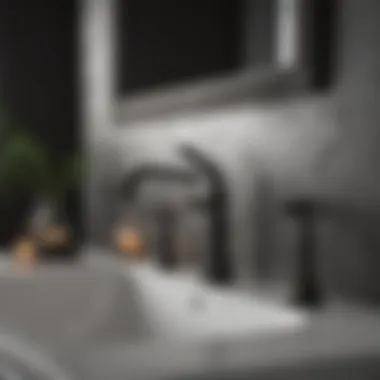
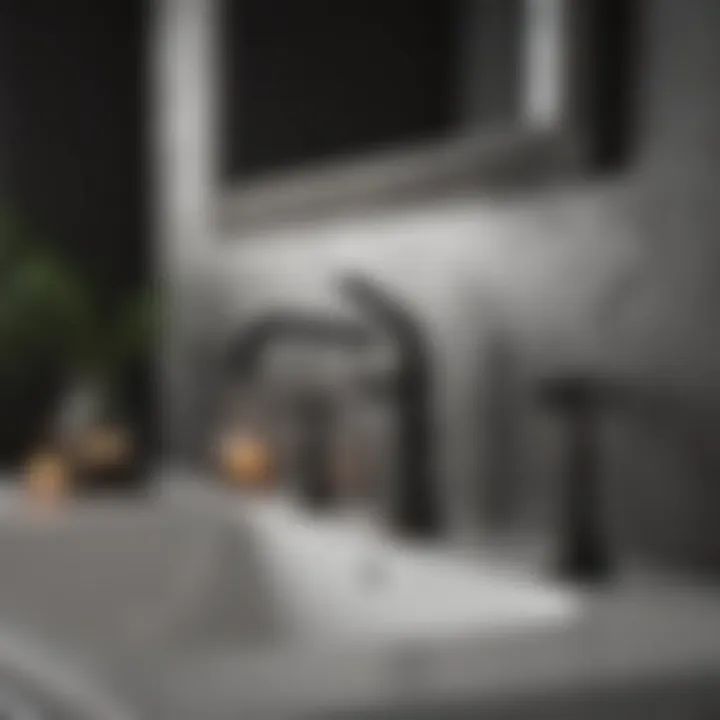
Feedback from users who have made the transition to dark faucets reveals several valuable strategies to mitigate common complaints. Some effective steps include:
- Regular Cleanings: Implementing a cleaning schedule can greatly reduce the accumulation of grime and spots.
- Choosing Durable Finishes: Opting for high-quality, scratch-resistant materials can lessen damage over time. For instance, faucets treated with PVD (Physical Vapor Deposition) coatings can enhance durability.
- Using Gentle Cleaning Agents: Utilizing non-abrasive cleaners will help maintain the finish of the faucet while keeping it maintained and looking fresh.
- Installing with Care: Ensuring proper installation can prevent issues related to plumbing connections shedding water into hidden areas that could cause long-term damage.
It is essential to focus on these considerations to enjoy the aesthetic benefits of dark faucets while minimizing the drawbacks. Understanding these challenges can greatly inform decision-making for those contemplating this style for their bathrooms.
Dark Faucets and Design Aesthetics
Dark bathroom faucets represent a significant shift in design aesthetics, influencing the overall look and feel of modern bathrooms. This choice goes beyond mere functionality; it encapsulates a deeper resonance with contemporary design philosophies. Emphasizing sleek lines and captivating finishes, dark faucets can serve as bold statement pieces or subtle accents, depending on their placement and pairing with other fixtures.
Pairing with Other Fixtures
When using dark faucets, it becomes essential to consider the compatibility with other bathroom fixtures. Well-chosen pairings enhance both functionality and style. For instance, when dark faucets are combined with lighter fixtures or contrasting materials like white sinks or bright tiles, it creates a striking visual dynamic. The key sitation here is finding a equilibrium; harmonious contrasts can draw the eye without overwhelming the space.
Ideas for Pairings:
- Lighting: Incorporate dark-hued fixtures with light fixtures just above the vanity for a cohesive look.
- Sink Material: Stone sinks, particularly in lighter colors, can balance the weighty feel of dark faucets.
Influence on Bathroom Themes
Dark faucets fit seamlessly into various design themes.
Minimalist
Minimalism is a design choice focused on simplicity and functionality. Here, clean lines and uncluttered surfaces prevail. Dark faucets become beneficial in this context as they provide an anchor point that offsets the utilitarian aspect. The best aspect of Minimalist design is its emphasis on quality over quantity. High-quality material practiced in dark faucets turns simple bathrooms into refined spaces.
Advantages:
- Familiarity with basic monochromatic schemes can be effectively enhanced with dark faucets.
- Offers concealment of marks or stains more effectively than light finishes.
Industrial
Industrial design embraces raw and rugged beauty, drawing inspiration from factories and warehouses. Dark faucets amplify this complexity and can bring a dose of sophistication to an otherwise utilitarian space. Recognizing these unique features makes them significant in setting a strong atmospheric tone.
Advantages:
- The look complements features like exposed bricks or metal that are typical in industrial design.
- Provides durability along with a fashionable appearance that can last through seasons.
Traditional
Traditional style often combines classic sophistication with cozy elements. Dark faucets present timeless elegance, connecting the old and modern aspects of Bathroom design. The key characteristic here lies in their ability to harmonize with traditional vanities and cabinetry, while the unique feature like intricate detailing adds a nuance not often found in standard bathroom elements.
Advantages:
- They reflect an appreciation for heritage and craftsmanship.
- Improves the smart appeal of conventional accents, offering a refreshing twist without sacrificing historical charm.
Overall, dark faucets underpin countless design schemes. Through thoughtful application and pairing, they are transformative elements that enhance the appeal and function of modern bathrooms, anchoring aesthetic dialogues across stylistic choices.
Closure: Evaluating the Trend
Evaluating the trend of dark bathroom faucets is key to understanding their rise in popularity. Homeowners seek bathroom fixtures that offer both practicality and an aesthetic appeal. The darker finishes have carved a niche because they can adapt beautifully to various styles and provide a fresh perspective on traditional designs. It is essential to weigh the benefits against potential concerns about maintenance and compatibility with existing installations.
Understanding the long-term value of dark faucets shows that these are not merely a fleeting trend but a worthwhile investment in home design. These faucets often enhance the overall ambiance of the bathroom, making it feel more elegant and modern. Here, we will take a closer look at this increasing trend and detail its long-lasting value as well as consider future design aspirations.
Long-Term Value of Dark Faucets
When considering the long-term value of dark faucets, it is crucial to acknowledge both their durability and their potential to maintain or even enhance property value. Many homeowners appreciate fixtures that stand the test of time, both in function and aesthetics. Dark faucets tend to hide water spots and stains better than lighter alternatives, thus requiring less frequent cleaning. Their inherent strength often comes from tougher finishes that resist tarnishing.
In practical terms, dark faucets can effectively blend with numerous styles, from minimalist to industrial designs. Such versatility ensures they remain relevant as trends evolve over time. A well-chosen dark faucet can serve as a beautiful focal point, drawing attention while consistently providing function.
Benefits of investing in dark faucets include:
- Versatility: They suit multiple styles and color pallettes.
- Durability: Many dark finishes resist wear better.
- Lower Maintenance: Less susceptible to showing stains.
A well-maintained dark faucet can remain a timeless piece in a bathroom for many years, contributing positively to both experience and value.
Future of Bathroom Design
The future of bathroom design continues to evolve, and dark faucets firmly occupy their space within it. As consumers lean toward bold choices, dark fixtures will likely become an even more integral part of bathroom remodeling themes. The emerging trend is not just a departure from lighter tones; it's a signal that interior design is advancing toward more dramatic, assertive styles.
With innovations in materials and finishes, manufacturers are offering enhanced functionality alongside striking designs. Beyond aesthetics, the demand for sustainable and eco-friendly materials is shaping the future of bathroom fixtures, including dark faucets. This shift will challenge designers and engineers to produce designs that harmonize with ecological standards without sacrificing style.
In summary, the trend of dark bathroom faucets is swelling due to functionality, vast choices, and adaptability. Those looking to embrace their aesthetics may do well to consider how dark options can elevate their personal spaces today, tomorrow, and long into the future.







